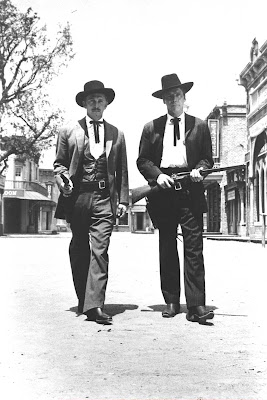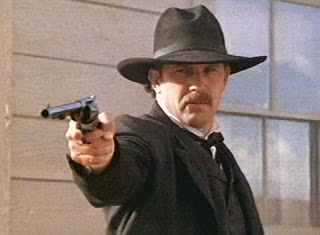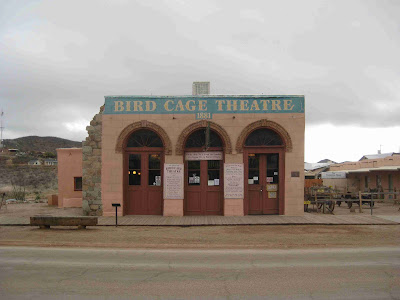Today, the town is still thriving. It’s certainly not as lively as it once was – all the tourist brochures boldly declare that this was once the biggest city between St. Louis and San Francisco – but it has managed to avoid the dismal fate of so many other ghost towns in the southwest, due mainly to tourism. Over the years, Hollywood has eagerly championed the legend of Tombstone, “the town too tough to die.”
Even if you’ve never been there, you probably know a few things about it. You’ve probably heard of Boot Hill, the cemetery to the north, where dozens of unlucky gunslingers are buried. (The grave stones are fun to read, as the old-timers apparently had a penchant for rhyming: “Here lies George Johnson – hanged by mistake, 1882 – He was right, we was wrong, but we strung him up and now he’s gone” / “Here lies Lester Moore – four slugs from a 44, no Les no more”) You’ve no doubt heard of the gunfight at the O.K. Corral, arguably the most famous showdown in the history of the Old West. Above all, you’re likely familiar with the name of Wyatt Earp, Tombstone’s famous (or infamous, depending on where you’re coming from) marshal… whose reputation suggests that he single-handedly brought law and order to the American frontier.
In a sense, the story of the O.K. Corral begins and ends at Boot Hill. One of the graves is that of town marshal Fred White, murdered in 1880 by a Cowboy named Curly Bill. “Cowboy” refers, in this case, to the infamous Clanton family and their loosely organized gang of outlaws that operated along the Mexican border. White’s replacement as town marshal was Virgil Earp, older brother of Wyatt Earp – a lawman from Dodge City. Both men, plus their brother Morgan and friend Doc Holliday, were involved in a shootout with the Cowboys on October 26, 1881. Three men were killed and buried in Boot Hill: Billy Clanton, Tom McLaury and Frank McLaury. This was neither the beginning nor the end of the hostilities between the two quasi-political factions in Tombstone, and it seems that everyone in town was forced to pick a side. History generally falls on the side of Wyatt Earp, due at least partly to the fact that the Tombstone Epitaph, one of the oldest continuously-operating newspapers in the West, reported the following: “The feeling among the best class of our citizens is that the Marshall was entirely justified in his efforts to disarm these men, and that being fired upon they had to defend themselves, which they did most bravely.”
Hollywood has generally sided with the Earps too, if only because the lionization of the lawmen has transformed the half-minute long gunfight into a modern myth. The pattern can be traced back to Wyatt Earp’s somewhat dubious 1931 biography, written by Stuart N. Lake. Lake opined that “the Old West cannot be understood unless Wyatt Earp is also understood” while asserting that “this biography is in no part a mythic tale.” The book became the basis for roughly two dozen movies including LAW & ORDER (1932) starring Walter Huston as Wyatt (the screenplay was written by his son John Huston), Alan Dwan’s FRONTIER MARSHAL (1939) starring Randolph Scott, and John Ford’s MY DARLING CLEMENTINE (1947) starring Henry Fonda. Dwan claimed to have a personal connection with Wyatt Earp, saying that he appeared as an extra in Dwan's film THE HALF-BREED (1916). After Earp’s widow sued Fox studios for inaccuracies in the film, however, Dwan announced that FRONTIER MARSHAL wasn’t supposed to be about Wyatt Earp specifically. (Nevermind that the main character is named “Wyatt Earp.”) Ford likewise claimed that MY DARLING CLEMENTINE had come straight from the horse’s mouth. He told French filmmaker Bertrand Tavernier, “I knew Wyatt Earp. I heard the story of the O.K. Corral from him. I was my brother’s assistant director and we made Westerns. The extras were real cowboys, actual friends of Earp’s. He often came around to see them, and so I had a chance to speak to him. He was very tall, a man of few words, remarkably calm. He wasn’t a good marksman, but he was very bold and so he would come very, very close to his opponent before shooting. This is the way it happens in my picture…”
His story may or may not be true. (I spoke with one Tombstone resident who loudly insisted that MY DARLING CLEMENTINE is the most “ridiculous” of all the Tombstone movies, because it shows Wyatt and Doc Holliday “not getting along.”) Either way, these films solidified the legend – making it difficult for future filmmakers to deviate from their “facts.” In his book Inventing Wyatt Earp, Allen Barra does an admirable job of untangling facts and fiction in these films and others including Jacques Tourneur’s WICHITA (1955), John Sturges’s GUNFIGHT AT THE O.K. CORRAL (1957) and HOUR OF THE GUN (1967), and the recent double-dose of TOMBSTONE (1993) with Kurt Russell and WYATT EARP (1994) with Kevin Costner. Autographed posters for these two latest incarnations appear everywhere in Tombstone, and the films themselves seemed to be in constant rotation at our hotel and the local saloon.
Upon arrival in Tombstone, we took a mule-powered stagecoach ride through the dusty streets. Our driver gave us a short town history and dropped us off at the back of the O.K. Corral, where we watched an elaborate reenactment of the gunfight and listened to Vincent Price narrating a “Historama” program that utilized 16mm reenactment footage and a hand-made diorama. As a horror fan, I was thrilled to hear Price’s voice, but it seemed a little odd since (as far as I know) the actor was only in two westerns: Sam Fuller’s gothic THE BARON OF ARIZONA (1950) and a lackluster South African remake of YELLOW SKY called THE JACKYLS (1967). Then again, the history of Tombstone is generally morbid and some of the locals do interpret the notion of “ghost town” literally (there’s a haunted stagecoach tour that runs at night)… so I guess it’s appropriate.
One of our most interesting stops was at The Bird Cage Theater, advertised as “the most haunted place in America.” 26 people were killed there in 8 years and, unlike most of the tourist stops in town, The Bird Cage still looks more or less the way it did in the 1880s. In fact, there are a few rooms in the basement – only recently opened to public view – that literally haven’t been touched since 1889. If this isn’t creepy enough for you, the theater also proudly displays advertisements for the local undertaker (“Why walk around half-dead when we can bury you for only $22?”), the hearse that carried the Cowboys to Boot Hill, and a rare mummified freak of nature (“a member of the family of nerrids that inhabited the China sea many centuries ago”). I think we can say that the town lives up to its name.

 Boot Hill Cemetery, looking down into Tombstone
Boot Hill Cemetery, looking down into Tombstone
 Allen Street (then and now)
Allen Street (then and now)
 Wyatt Earp's house on Fremont Street
Wyatt Earp's house on Fremont Street Henry Fonda in MY DARLING CLEMENTINE
Henry Fonda in MY DARLING CLEMENTINE Kirk Douglas (as Doc) and Burt Lancaster (as Wyatt) in GUNFIGHT AT THE O.K. CORRAL
Kirk Douglas (as Doc) and Burt Lancaster (as Wyatt) in GUNFIGHT AT THE O.K. CORRAL Val Kilmer (as Doc), Sam Elliot (as Virgil), Kurt Russell (as Wyatt) and Bill Paxton (as Morgan) in TOMBSTONE
Val Kilmer (as Doc), Sam Elliot (as Virgil), Kurt Russell (as Wyatt) and Bill Paxton (as Morgan) in TOMBSTONE Kevin Costner in WYATT EARP
Kevin Costner in WYATT EARP







No comments:
Post a Comment